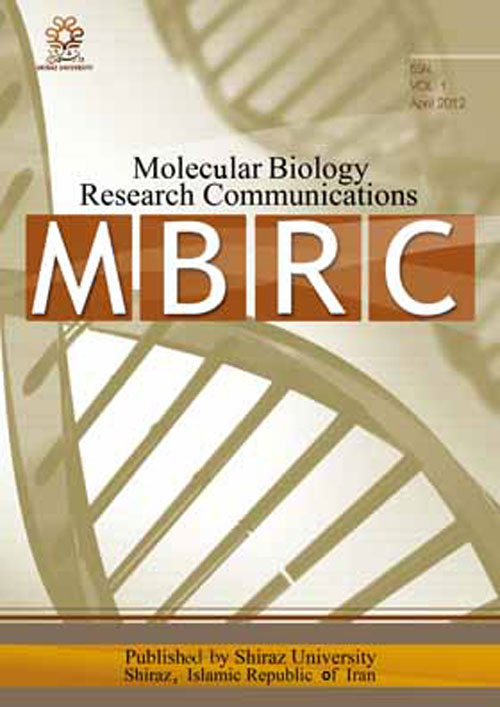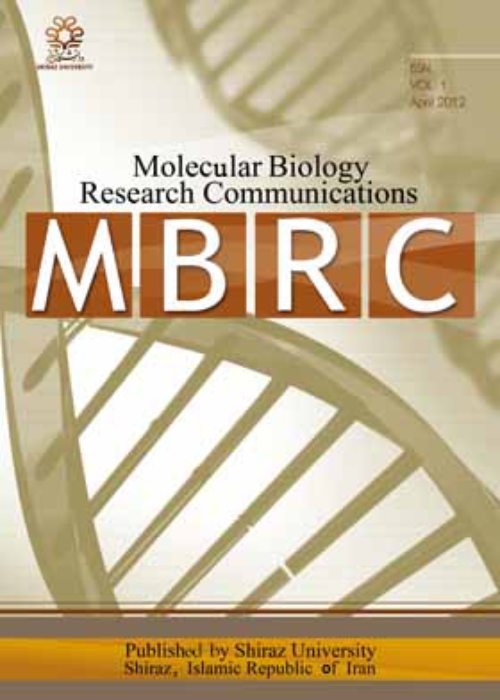فهرست مطالب

Molecular Biology Research Communications
Volume:4 Issue: 3, Sep 2015
- تاریخ انتشار: 1394/06/16
- تعداد عناوین: 6
-
-
Pages 115-124Quorum sensing controls the luminescence of Vibrio fischeri through the transcriptional activator LuxR and the specific autoinducer signal produced by luxI. Amino acid sequences of these two genes were analyzed using bioinformatics tools. LuxI consists of 193 amino acids and appears to contain five α-helices and six ß-sheets when analyzed by SSpro8. LuxI belongs to the autoinducer synthetase family and contains an acetyltransferase domain extending from residues 24 to 110 as MOTIF predicted. LuxR, on the other hand, contains 250 amino acids and has ten α-helices and four ß-sheets. MOTIF predicted LuxR to possess functional motifs; the inducer binding site extending from amino acid residues 23 to 147 and the LuxR activator site extending between amino acids 182 and 236. The InterProScan5 server identified a winged helix-turn-helix DNA binding motif.Keywords: Quorum sensing, Vibrio fischeri, Motifs
-
Pages 125-132Myxozoans are an economically important group of microscopic parasites best known for the diseases they cause in commercially important fish hosts. The classification of myxosporeans is generally based on the morphology of their myxospores. Without molecular data, it is very difficult to identify new or existing species. DNA sequence information is therefore, a prerequisite to taxonomic and phylogenic studies of myxosporeans. In the present study, a myxozoan parasite, Myxobolus carnaticus,infecting the gill lamellae of mrigal carp, Cirrhinus mrigala,was characterized by the 18S rRNA gene sequence. The DNA sequence of M. carnaticus clustered phylogenetically with other gill infecting Myxobolus spp. of freshwater clades, forming a dichotomy with closely related M. pavlovskii (HM991164) that infects the gill lamellae epithelium of silver carp, Hypophthalmichthys molitrix with 95% similarity. Evolutionary pair-wise distances among M. carnaticus and other species of myxosporeans indicated high genetic diversity among myxosporeans. The present study demonstrated that tissue tropism, host specificity and habitat play important roles in phylogenetic relationships among myxozoan species.Keywords: Cirrhinus mrigala, Myxobolus carnaticus, gill myxoboliasis, Molecular phylogeny
-
Pages 133-142Sodium/proton exchangers (NHX) are key players in plant responses to salinity and have a central role in establishing ion homeostasis. NHXs can be localized in tonoplast or plasma membranes, where they exchange sodium ions for protons, resulting in the removal of ions from the cytosol into vacuole or extracellular spaces. In the present study, the expression pattern of the gene encoding Na+/H+ antiporter in the vacuolar membrane (NHX1 gene) in Leptochloa fusca (Kallar grass) was measured by a semi-quantitative RT-PCR method under different treatments of NaCl and CdCl2. Results indicated that NaCl positively affected expression levels of LfNHX1, and that the amount of LfNHX1 mRNA increased in conjunction with the rise of salinity pressure, This finding suggests that vacuolar Na+/H+ antiporter might play an important role in the salt tolerance ability of kallar grass. The results also showed that cadmium exposure significantly modulated the mRNA expression of the LfNHX1 gene, suggesting that cadmium exposure disturbed Na+ homeostasis across the tonoplast and decreased the salt tolerance ability of kallar grass.Keywords: Kallar grass, Salt stress, Cadmium, NHX1, Semi, quantitative RT, PCR
-
Pages 143-149Cataract is multi-factorial eye disease identified by the disturbance of the transparent ocular lens. There is significant evidence suggesting oxidative damage as a major cause of initiation and progression of numerous diseases including cataracts. NAD(P)H:quinone oxidoreductase 1 (NQO1; OMIM: 125860) and catalase (CAT, OMIM: 115500) are antioxidant enzymes that prevent cells from oxidative stress. The aim of the present study was to investigate the association between NQO1 C609T (Pro189Ser, rs1800566) and CAT promoter C-262T (rs1001179) genetic polymorphisms and the susceptibility to cataracts. A case-control study including 190 cataracts cases and 190 healthy subjects was carried out. Genotype distributions of NQO1 and CAT polymorphisms were examined using polymerase chain reactions and a restriction fragment length polymorphism (PCR-RFLP) approach to investigate the possible role of these polymorphisms as risk factors in the development of cataracts. Variant CT heterozygous and TT genotypes of the NQO1 C609T polymorphism were found to be associated with an increased risk of cataracts (CT vs CC, OR=1.61, 95%CI: 1.02-2.52, P=0.038), (CT/TT vs CC, OR=1.56, 95%CI: 1.02-2.4, P=0.040). In addition, compared to indoor work places and the CC genotype of NQO1, outdoor work places and CT/TT genotypes of NQO1 were found to increase the risk of age-related cataracts (OR=2.75, 95%CI: 1.20-6.33, P=0.017). The analysis did not reveal, however, any statistically significant (P>0.05) difference between CAT C-262T polymorphism and the risk of cataracts.Keywords: Cataract, CAT, Genetic polymorphism, NQO1
-
Pages 151-159Tyrosinase is a multifunctional copper-containing enzyme. It can catalyze two distinct reactions of melanin synthesis and benzaldehyde derivatives, which are potential tyrosinase inhibitors. To find the relationships between charge distributions of benzaldehyde and their pharmaceutical behavior, the present study aimed at investigating nuclear quadrupole coupling constants of quadrupolare nuclei in the functional benzaldehyde group and calculating some its derivatives. In addition, the differences between the electronic structures of various derivatives of this depigmenting drug were examined. All ab initio calculations were carried out using Gaussian 03. The results predicted benzaldehyde derivatives to be bicentral inhibitors; nevertheless, the oxygen or hydrogen contents of the aldehyde group were not found to be the only active sites. Furthermore with the presence of the aldehyde group, the terminal methoxy group in C4 was found to contribute to tyrosinase inhibitory activities. In addition, an oxygen atom with high charge density in the side chain was found to play an important role in its inhibitory effect.Keywords: Charge density, NQR, Gaussian, quadrupolar nuclei
-
Pages 161-165Gamma-amino butyric acid (GABA) possesses several physiological functions such as neurotransmission, induction of hypotension, diuretic and tranquilizer effects. Production of GABA-enriched products by lactic acid bacteria has been a focus of different researches in recent years because of their safety and health-promoting specifities. In this study, glutamate decarboxylase (gad) gene of a local strains Lactobacillus casei was identified and cloned. In order to clone the gad gene from this strain, the PCR was carried out using primers designed based on conserved regions. The PCR product was purified and ligated into PGEM-T vector. Comparison of obtained sequences shows that this fragment codes the pyridoxal 5′-phosphate binding region. This strain could possibly be used for the industrial GABA production and also for development of functional fermented foods. Gad gene manipulation can also either decrease or increase the activity of enzyme in bacteria.Keywords: Gamma, aminobutyric acid, Glutamate decarboxylase, Lactobacillus casei


